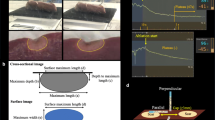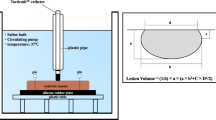Abstract
Background
Although ablation energy (AE) and force-time integral (FTI) are well-known active predictors of lesion characteristics, these parameters do not reflect passive tissue reactions during ablation, which may instead be represented by drops in local impedance (LI). This study aimed to investigate if additional LI data improves predicting lesion characteristics and steam pops.
Methods
RF applications at a range of powers (30 W, 40 W, and 50 W), contact forces (8 g, 15 g, 25 g, and 35 g), and durations (10–180 s) using perpendicular/parallel catheter orientations were performed in excised porcine hearts (N = 30). The correlation between AE, FTI, and lesion characteristics was examined, and the impact of LI (%LI drop (%LID) defined by the ΔLI divided by the initial LI) was additionally assessed.
Results
Three hundred seventy-five lesions without steam pops were examined. Ablation energy (W × s) and FTI (g × s) showed a positive correlation with lesion depth (ρ = 0.824:P < 0.0001 and ρ = 0.708:P < 0.0001), surface area (ρ = 0.507:P < 0.0001 and ρ = 0.562:P < 0.0001), and volume (ρ = 0.807:P < 0.0001 and ρ = 0.685:P < 0.0001). %LID also showed a positive correlation individually with lesion depth (ρ = 0.643:P < 0.0001), surface area (ρ = 0.547:P < 0.0001), and volume (ρ = 0.733:P < 0.0001). However, the combined indices of AE × %LID (AE multiplied by %LID) and FTI × %LID (FTI multiplied by %LID) provided significantly stronger correlation with lesion depth (ρ = 0.834:P < 0.0001 and ρ = 0.809:P < 0.0001), surface area (ρ = 0.529:P < 0.0001 and ρ = 0.656:P < 0.0001), and volume (ρ = 0.864:P < 0.0001 and ρ = 0.838:P < 0.0001). This tendency was observed regardless of the catheter placement (parallel/perpendicular). AE (P = 0.02) and %LID (P = 0.002) independently remained as significant predictors to predict steam pops (N = 27). However, the AE × %LID did not increase the predictive power of steam pops compared to the AE alone.
Conclusion
LI, when combined with conventional parameters (AE and FTI), may provide stronger correlation with lesion characteristics.








Similar content being viewed by others
References
Calkins H, Hindricks G, Cappato R, Kim YH, Saad EB, Aguinaga L, et al. 2017 HRS/EHRA/ECAS/APHRS/SOLAECE expert consensus statement on catheter and surgical ablation of atrial fibrillation. Europace. 2018;20:e1–e160.
El Haddad M, Taghji P, Phlips T, et al. Determinants of acute and late pulmonary vein reconnection in contact force-guided pulmonary vein isolation. Circ Arrhythmia Electrophysiol. 2017;10.
Ikeda A, Nakagawa H, Lambert H, Shah DC, Fonck E, Yulzari A, et al. Relationship between catheter contact force and radiofrequency lesion size and incidence of steam pop in the beating canine heart: Electrogram amplitude, impedance, and electrode temperature are poor predictors of electrode-tissue contact force and lesion. Circ Arrhythmia Electrophysiol. 2014;7:1174–80.
Ariyarathna N, Kumar S, Thomas SP, Stevenson WG, Michaud GF. Role of contact force sensing in catheter ablation of cardiac arrhythmias: evolution or history repeating itself? JACC Clin. Electrophysiol. 2018;4:707–23.
Garrott K, Laughner J, Gutbrod S, et al.: Combined local impedance and contact force for radiofrequency ablation assessment. Heart Rhythm Elsevier Inc., 2020; :0–9.
Sheskin DJ. Handbook of parametric and nonparametric statistical procedures. Proced: Handb. Parametr. Nonparametric Stat; 2011.
Thiagalingam A, D’Avila A, Foley L, et al. Importance of catheter contact force during irrigated radiofrequency ablation: evaluation in a porcine ex vivo model using a force-sensing catheter. J Cardiovasc Electrophysiol. 2010;21:806–11.
Avitall B, Mughal K, Hare J, Helms R, Krum D. The effects of electrode-tissue contact on radiofrequency lesion generation. PACE - Pacing Clin Electrophysiol. 1997;20:2899–910.
Harvey M. Kim Y -N, Sousa J, et al.: Impedance monitoring during radiofrequency catheter ablation in humans. Pacing Clin Electrophysiol. 1992;15:22–7.
Sulkin MS, Laughner JI, Hilbert S, et al. Novel measure of local impedance predicts catheter-tissue contact and lesion formation. Circ Arrhythmia Electrophysiol. 2018;11:1–11.
Martin CA, Martin R, Gajendragadkar PR, Maury P, Takigawa M, Cheniti G, et al. First clinical use of novel ablation catheter incorporating local impedance data. J Cardiovasc Electrophysiol. 2018;29:1197–206.
Iwakawa H, Takigawa M, Goya M, Iwata T, Martin CA, Anzai T, et al. Clinical implications of local impedance measurement using the IntellaNav MiFi OI ablation catheter: an ex vivo study. J Interv Card Electrophysiol Journal of Interventional Cardiac Electrophysiology. 2021. https://doi.org/10.1007/s10840-021-00954-8.
Ullah W, Hunter RJ, Baker V, Dhinoja MB, Sporton S, Earley MJ, et al. Target indices for clinical ablation in atrial fibrillation: insights from contact force, electrogram, and biophysical parameter analysis. Circ Arrhythmia Electrophysiol. 2014;7:63–8.
Nakagawa H, Ikeda A, Govari A, et al.: Prospective study using a new formula incorporating contact force, radiofrequency power and application time (force-power-time index) for quantifying lesion formation to guide long continuous atrial lesions in the beating canine heart. Circulation 2013; 128:A12104 LP-A12104.
Mori H, Kato R, Sumitomo N, et al. Relationship between the ablation index, lesion formation, and incidence of steam pops. J Arrhythmia. 2019;35:636–44.
Shah DC, Lambert H, Nakagawa H, Langenkamp A, Aeby N, Leo G. Area under the real-time contact force curve (force-time integral) predicts radiofrequency lesion size in an in vitro contractile model. J Cardiovasc Electrophysiol. 2010;21:1038–43.
Calzolari V, De Mattia L, Indiani S, et al. In vitro validation of the lesion size index to predict lesion width and depth after irrigated radiofrequency ablation in a porcine model. JACC Clin Electrophysiol. 2017;3:1126–35.
F. Bourier, J. Duchateau, K. Vlachos, A. Lam, C. Martin, M. Takigawa, T. Kitamura, A. Frontera, G. Cheniti, T. Pambrun, N. Klotz, A. Denis, N. Derval, H. Cochet, F. Sacher, M. Hocini, M. Haissaguerre PJ: High power short duration vs. standard RF ablation: insights on lesion metrics. J Cardiovasc Electrophysiol 2018; 29:1570–1575, High‐power short‐duration versus standard radiofrequency ablation: Insights on lesion metrics.
Bourier F, Ramirez FD, Martin CA, Vlachos K, Frontera A, Takigawa M, et al. Impedance, power, and current in radiofrequency ablation: insights from technical, ex vivo, and clinical studies. J Cardiovasc Electrophysiol. 2020;31:2836–45.
Yokoyama K, Nakagawa H, Shah DC, Lambert H, Leo G, Aeby N, et al. Novel contact force sensor incorporated in irrigated radiofrequency ablation catheter predicts lesion size and incidence of steam pop and thrombus. Circ Arrhythm Electrophysiol. 2008;1:354–62.
Stagegaard N, Petersen HH, Chen X, Svendsen JH. Indication of the radiofrequency induced lesion size by pre-ablation measurements. Europace. 2005;7:525–34.
Dumas JH, Himel HD IV, Kiser AC, Quint SR, Knisley SB. Myocardial electrical impedance as a predictor of the quality of RF-induced linear lesions. Physiol Meas. 2008;29:1195–207.
Nazeri A, Ganapathy A, Massumi A, et al. Contact-force recovery can predict cardiac perforation during radiofrequency ablation. PACE - Pacing Clin Electrophysiol. 2014;37:1129–32.
Bourier F, Vlachos K, Frontera A, Martin CA, Lam A, Takigawa M, et al. In silico analysis of the relation between conventional and high-power short-duration RF ablation settings and resulting lesion metrics. J Cardiovasc Electrophysiol. 2020;31:1332–9.
Nakagawa H, Yamanashi WS, Pitha JV, Arruda M, Wang X, Ohtomo K, et al. Comparison of in vivo tissue temperature profile and lesion geometry for radiofrequency ablation with a saline-irrigated electrode versus temperature control in a canine thigh muscle preparation. Circulation. 1995;91:2264–73.
Seiler J, Roberts-Thomson KC, Raymond JM, Vest J, Delacretaz E, Stevenson WG. Steam pops during irrigated radiofrequency ablation: feasibility of impedance monitoring for prevention. Heart Rhythm. 2008;5:1411–6.
Acknowledgements
We are grateful to Mr. Tomohiro Nagao, an employee of Boston Scientific Japan, for the technical support for this experiment.
Funding
This work was supported by JSPS KAKENHI Grant Number JP20K17074.
Author information
Authors and Affiliations
Corresponding author
Ethics declarations
Conflict of interest
Dr. Martin has received consulting fees from Boston Scientific.
Additional information
Publisher’s note
Springer Nature remains neutral with regard to jurisdictional claims in published maps and institutional affiliations.
Supplementary information
ESM 1
(PNG 944 kb)
Rights and permissions
About this article
Cite this article
Takigawa, M., Goya, M., Iwakawa, H. et al. Impact of a formula combining local impedance and conventional parameters on lesion size prediction. J Interv Card Electrophysiol 63, 389–398 (2022). https://doi.org/10.1007/s10840-021-01013-y
Received:
Accepted:
Published:
Issue Date:
DOI: https://doi.org/10.1007/s10840-021-01013-y




